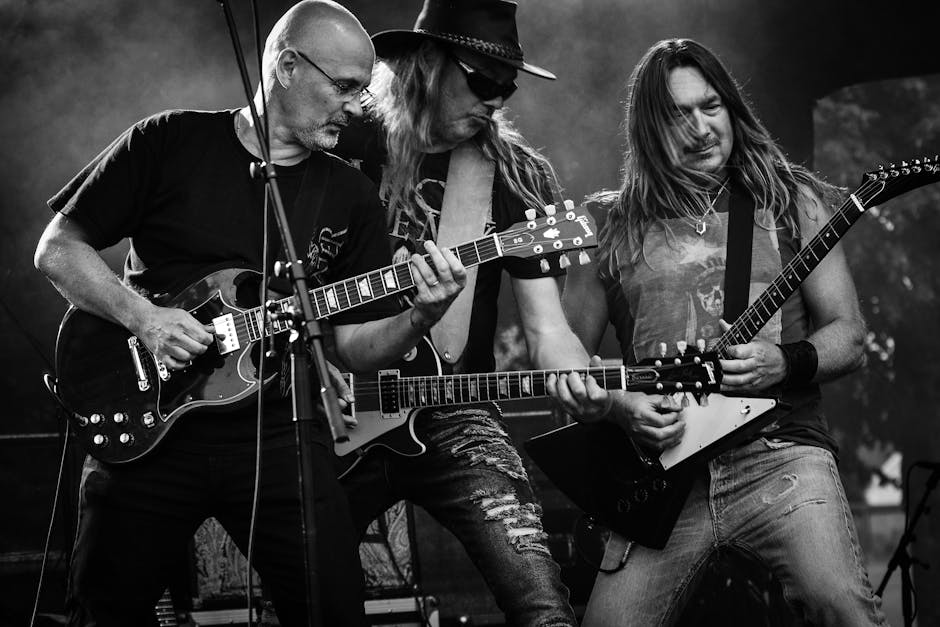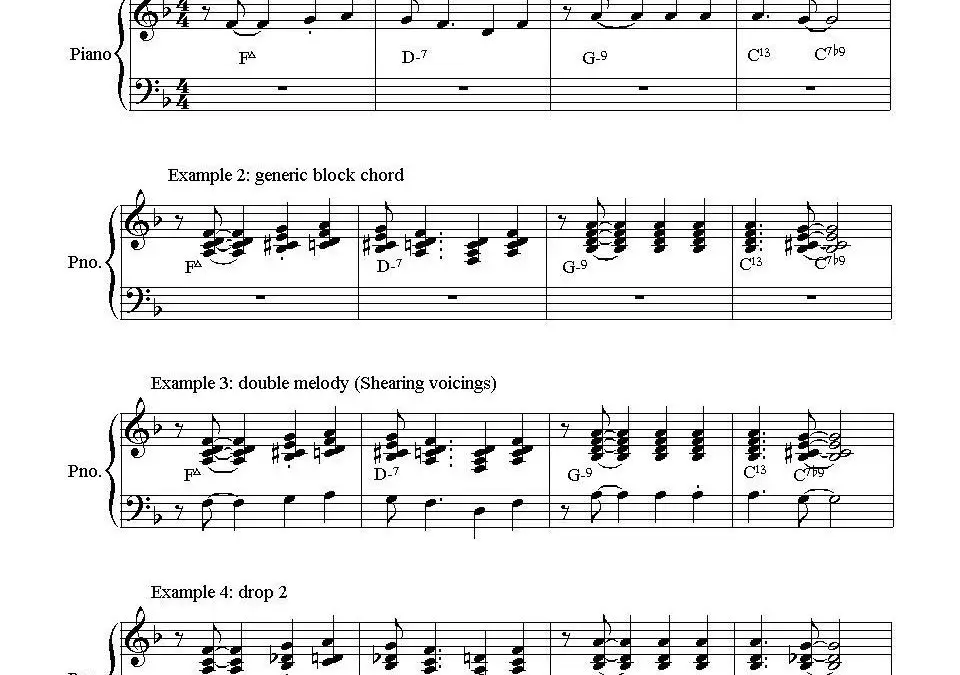Have you ever listened to a song and thought, “Wow, that chord progression really hits the spot”? Or maybe you’ve found yourself tapping your foot to a catchy tune and wondered just what makes that sequence of chords so darn pleasing? Well, prepare to delve into the wonderfully weird world of key chord progressions in different music genres. From the smooth grooves of jazz to the head-banging rhythms of rock, we’re about to take you on a musical journey that will have you saying, “Who knew those four little notes could sound so good?” So grab your earbuds and get ready to explore the key to unlocking the magic of chord progressions in music.
Contents
- 1 Understanding the Backbone of Blues: The I-IV-V Progression
- 2 Navigating the Nuances of Jazz: ii-V-I and Beyond
- 3 The Heartbeat of Rock: Power and Progression
- 4 Country Music’s Core: The Timeless Three-Chord Songs
- 5 The Unique Tapestry of Pop: Versatility in Chord Progressions
- 6 Exploring the Depths of Classical Music: Harmony and Evolution
- 7 The Electronic Landscape: Minimalism and Complexity in Chord Structures
- 8 FAQs
- 9 Time to Jam!
Understanding the Backbone of Blues: The I-IV-V Progression
Have you ever found yourself tapping your feet and swaying to the music of a blues song, not quite sure why it has such a captivating rhythm? Well, let me introduce you to the I-IV-V progression, the unsung hero of blues music.
At the heart of every blues song lies this simple yet powerful chord progression. It’s like the secret sauce that gives blues its flavor, its soul, its groove. But what exactly is this mysterious I-IV-V progression? Let me break it down for you in plain, musical terms:
- The I chord: This is your home base, the tonic, the starting point. It sets the stage for the entire song, establishing the key and laying down the foundation for what’s to come.
- The IV chord: This chord adds a little twist to the mix, taking you on a journey away from home before bringing you back to familiar territory. It’s like that unexpected detour that somehow feels just right.
- The V chord: Ah, the climax of the progression. This chord builds tension and anticipation, leading you to that satisfying resolution back to the I chord. It’s the musical equivalent of a plot twist, keeping you on the edge of your seat until the very end.
So, the next time you find yourself grooving along to a blues tune, remember to give a nod to the I-IV-V progression. It’s the backbone of blues music, the glue that holds it all together, the magic ingredient that keeps you coming back for more. Now, go forth and spread the gospel of the I-IV-V progression to all the music lovers in your life. Blues will never sound the same again!

So you wanna dabble in the magical world of jazz, huh? Well, buckle up buttercup, because we’re about to dive into the ii-V-I progression and all its quirky little friends.
First things first, let’s talk about the ii-V-I. It’s like the holy trinity of jazz progressions. The ii chord sets the stage, the V chord adds that spicy tension, and the I chord brings it all back home. It’s like a rollercoaster of emotions, but in music form.
But wait, there’s more! Jazz is full of surprises and unexpected twists and turns. So strap in as we explore the endless possibilities that lie beyond the ii-V-I. From tritone substitutions to superimposing chords, the jazz world is your oyster. Just remember, rules are meant to be broken in jazz. So don’t be afraid to get a little wild and experiment.
So there you have it, my fellow jazz adventurers. The world of ii-V-I and beyond is vast and full of wonders. So grab your instrument of choice, throw on your beret, and let’s get groovin’ to the sweet sounds of jazz.

The Heartbeat of Rock: Power and Progression
Rock music has always been known for its powerful beats and progressive sound. The heartbeat of rock lies in the raw energy and unapologetic attitude that define the genre.
From the pounding drums to the screeching guitars, every element of rock music is designed to make you feel something deep down in your soul. It’s like a musical punch to the gut, in the best possible way.
With its roots in blues and jazz, rock music has evolved over the years to incorporate elements of other genres, creating a truly unique sound that resonates with fans around the world.
Whether you’re headbanging to classic rock anthems or immersing yourself in the latest progressive rock masterpiece, one thing is for sure – the heartbeat of rock is loud, proud, and ready to take you on a musical journey like no other.

Country Music’s Core: The Timeless Three-Chord Songs
There’s something undeniably magical about a three-chord country song. It’s like the universe decided that simplicity was key, and who are we to argue? These timeless tunes have been the backbone of country music for decades, and they continue to be the crowd favorites at every honky-tonk from Nashville to Texas. So saddle up, grab your cowboy hat, and let’s take a musical journey through the heart of country music.
First up, we have the classic country ballad. These songs are like a fine wine - they only get better with age. With just three chords, a heartfelt lyric, and a twangy guitar, artists like Johnny Cash and Patsy Cline created songs that still have fans swooning to this day. It’s the kind of music that will have you drying your tears with your ten-gallon hat while simultaneously reaching for a cold beer.
Next, we can’t talk about three-chord country songs without mentioning the toe-tappers. These upbeat tunes are perfect for a two-stepping good time at the local dancehall. From George Strait to Dolly Parton, these songs will have you kicking up your heels and singing along at the top of your lungs. It’s a guaranteed good time, y’all.
And last but certainly not least, we have the defiant anthems. These songs are like a shot of whiskey – they hit you hard and leave you feeling invincible. With lyrics that speak to the rebel in all of us, artists like Merle Haggard and Loretta Lynn paved the way for generations of country misfits. So next time you’re feeling a little rebellious, crank up the volume on one of these three-chord wonders and let the outlaw in you run wild. Let’s raise our glasses to the timeless three-chord songs that have stood the test of time in the world of country music. Cheers!
The Unique Tapestry of Pop: Versatility in Chord Progressions
When it comes to pop music, one of the key elements that make it stand out is the versatility in chord progressions. From catchy hooks to emotional ballads, pop music truly weaves a unique tapestry of sound that keeps listeners hooked.
Not only do pop songs have the ability to get stuck in your head for days, but they also have a way of tugging at your heartstrings with their clever chord progressions. Whether it’s a simple I-V-IV or a complex jazz-infused sequence, pop music knows how to keep you on your toes.
With pop music, you never know what to expect next when it comes to chord progressions. One minute you’re tapping your foot to a classic I-IV-V, and the next you’re swaying along to a minor key change that takes you by surprise. Pop music is like a box of chocolates – you never know what you’re gonna get, but you’re always in for a treat.
So, the next time you find yourself bopping along to your favorite pop song, take a moment to appreciate the intricate chord progressions that make it such a hit. Pop music truly is a master at weaving an eclectic mix of chords that keep us coming back for more.
Exploring the Depths of Classical Music: Harmony and Evolution
When diving into the realm of classical music, one cannot ignore the intricate harmony that weaves its way through each composition. From the delicate balance of strings to the robust power of brass, the harmonies in classical music are like a beautifully choreographed ballet of musical notes.
As we explore the evolution of classical music, we see how these harmonies have transformed over the centuries. From the simplicity of Gregorian chants to the complexity of symphonies, classical music has evolved and adapted to fit the changing tastes of society. Each era brings its own unique twist on harmony, from the Baroque period’s elaborate basso continuo to the Romantic period’s lush, sweeping melodies.
But despite these changes, one thing remains constant: the beauty and power of classical music’s harmonies. They have the ability to transport us to another world, to evoke emotions we never knew we had, and to connect us to something greater than ourselves. So next time you listen to a classical piece, take a moment to appreciate the harmony that lies at the heart of it all.
The Electronic Landscape: Minimalism and Complexity in Chord Structures
When exploring the electronic landscape, one can’t help but notice the fascinating interplay between minimalism and complexity in chord structures. It’s like watching a high-stakes game of musical Jenga, where every carefully placed chord creates a delicate balance between simplicity and intricacy.
On one hand, you have the minimalists, wielding their sleek, stripped-down chord progressions like precision instruments. Their motto could very well be “less is more,” as they effortlessly weave together sparse arrangements that pack a powerful punch. It’s a zen-like approach to music making, where every note carries weight and purpose.
On the other end of the spectrum, you have the complexity enthusiasts, who revel in pushing the boundaries of chord structures to their absolute limit. Their compositions are like intricate spiderwebs, filled with unexpected twists and turns that keep listeners on their toes. It’s a dizzying, exhilarating ride through a musical maze of their own creation.
In the end, whether you’re drawn to the simplicity of a minimalist chord progression or the mind-boggling complexity of a more intricate structure, one thing’s for sure – the electronic landscape is a playground where creativity knows no bounds. So crank up the volume, sit back, and let the magic of minimalism and complexity in chord structures whisk you away on a sonic adventure like no other.
FAQs
What makes chord progressions in each music genre unique?
Well let me tell you, each music genre has its own secret sauce when it comes to chord progressions. From the melancholic minor chords of blues to the jazzy complex progressions of jazz, each genre brings its own flavor to the table.
How can chord progressions affect the mood of a song?
Oh, chord progressions are like the mood ring of a song. They can make you feel happy, sad, nostalgic, or even pumped up. Just like how eating ice cream can instantly make you feel better, a good chord progression can change the whole vibe of a song.
Are there any common chord progressions that are used across multiple genres?
Absolutely! Some chord progressions are like the popular kids in school that everyone wants to hang out with. The good ol’ I-IV-V progression is a classic that you can find in everything from rock to pop to country music. It’s like the chameleon of chord progressions, fitting in wherever it goes.
How can musicians use key chord progressions to experiment and innovate in their music?
Think of chord progressions as your playground. You can swing from simple to complex progressions, slide from major to minor chords, and even see-saw between different keys. The key is to be open to exploring new sounds and not be afraid to break the rules. After all, music is all about creativity and expression.
Time to Jam!
And there you have it, folks! Armed with these key chord progressions, you’re now ready to take on the musical world by storm. So grab your guitar, sit down at your piano, or fire up your favorite music production software, because it’s time to jam out like never before. Whether you’re into the smooth vibes of jazz, the soulful sounds of blues, or the infectious beats of pop, these chord progressions will be your trusty sidekick on your musical journey. So go ahead, explore, experiment, and most importantly, have fun making some killer tunes!



